STEEM Course: IPv4 Routing Primer (Part 2)
Hello and welcome, I am currently working on a video course regarding Routing for IP version 4, and I've decided to post my slides and scripts here on STEEM as I go along. I appreciate any feedback or suggestions, or if you are new to the world of computer networking, I hope you enjoy them! If you are brand new to the topic, I recommend that you review my previous course posted on STEEM titled IP Version 4 Addressing And Subnetting Deep Dive.
Here is part 2 of a multi-part series. In this section, we will briefly discuss the purpose of routing, along with a review of CIDR and VLSM. How many parts will there be? I have no idea because I am posting them as I go along. This and all @steempeak initiated posts will have a 4% beneficiary set to @null to help fight inflation.
If you missed any sections, click one of the links below for your favorite front end:
PART 1:
https://steempeak.com/stem/@joshman/steem-course-ipv4-routing-primer-part-1
https://busy.org/@joshman/steem-course-ipv4-routing-primer-part-1
https://steemit.com/stem/@joshman/steem-course-ipv4-routing-primer-part-1
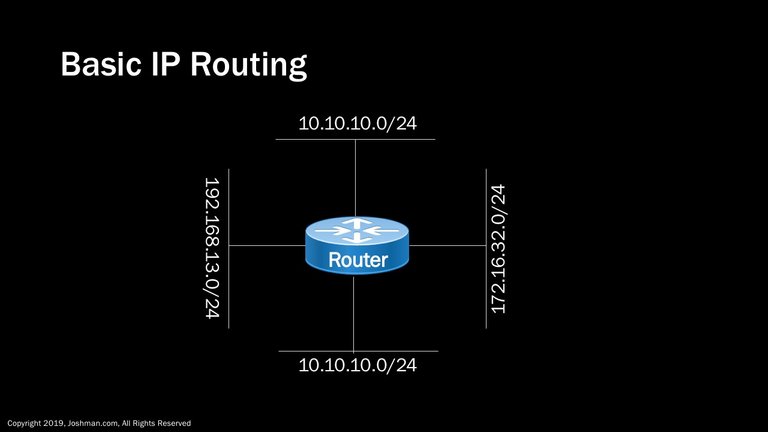
A router is simply a device that allows different networks to communicate. In the example we have 4 different networks connected to a router. The devices on each LAN can reach other devices on their respective networks, however they will require a router in order to communicate with devices on other networks. To communicate with other networks, these devices must do so via their local default gateway. Without the router in the middle, these individual networks would have no way to communicate with one another.
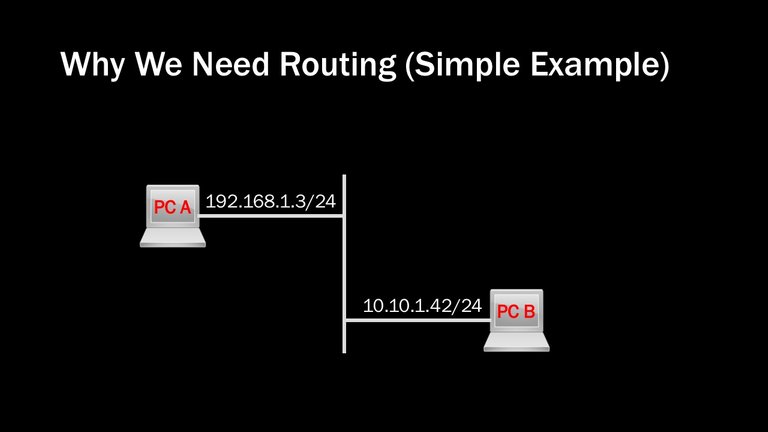
So why do we need routing? Why can’t we just pick any two random IP addresses for PCs and expect them to communicate?
In our simple example we have to computers connected physically to the same Local Area Network(LAN). Each is assigned an IP address on a different logical network. Both PCs can generate traffic on the LAN, but the IP stack on each PC will ignore any traffic destined for an address on another network. These two networks will operate independently like ‘ships in the night’ at the network layer, even though they will still compete for resources on the LAN.
For these two devices to communicate with one another, a layer 3 device (router) is required.
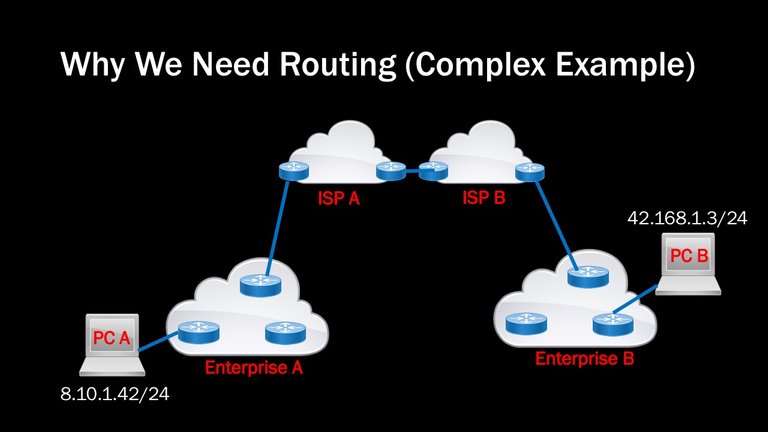
Let’s look at a more complex example of why routing is required. Let’s imagine that PCA and PCB have public IP addresses and are each connected to an enterprise network. Each enterprise Enterprise A and Enterprise B receives services from a different Internet Service Provider, we’ll call them ISP A, and ISP B. The enterprise networks, won’t inherently know about the existence of of the distant enterprise networks, and the Internet service providers, won’t inherently know about these networks either. Even individual devices within these enterprises and ISPs wouldn’t know about their own IP addresses without routing. Routing is the mechanism by which we share this information!
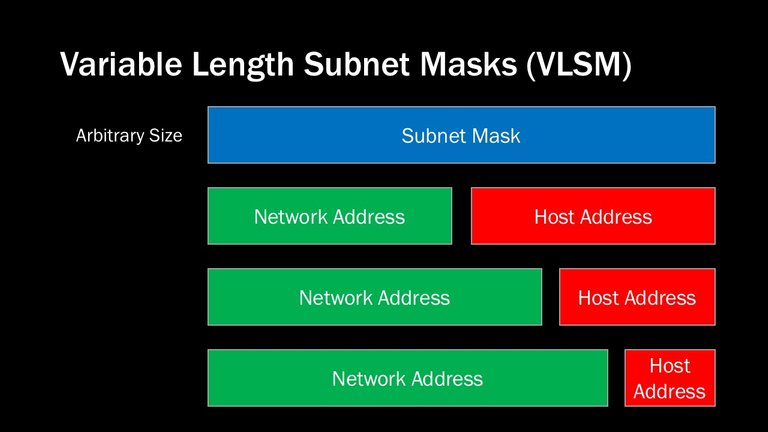
Let’s do a quick review in these next three slides of CIDR and VLSM taken from my previous course, IP Version 4 Addressing And Subnetting Deep Dive.
VLSM creates the ability for us to carve up networks into a variety of sizes and greatly increase the efficiency of IP address allocation.
Variable length subnet masks or VLSM, removes the hard boundaries of classful addresses, which is the original inefficient way of address allocation. The subnet mask in VLSM can be an arbitrary size of zero to thirty two bits. Though the majority used are /16 or longer. This technique allows us to route everything from a single IP address, to the size of a Class A.
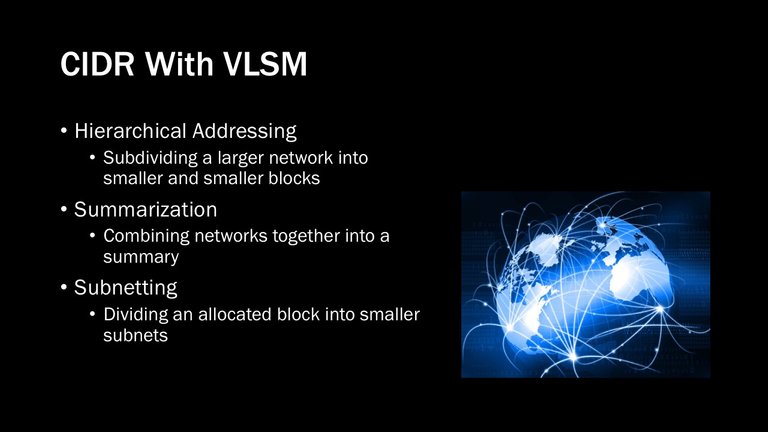
Classless Interdomain Routing(CIDR—also pronounced cider), it taking the concept of variable length subnet masks and applying it to IP routing, that is how the various network addresses get announced to one another on the internet. With CIDR, variable length subnet masks are expressed using CIDR notation. This is simply the number of bits in the subnet mask from zero to thirty two. Unlike with classful addressing, CIDR always includes the subnet mask along with the IP address when routing.
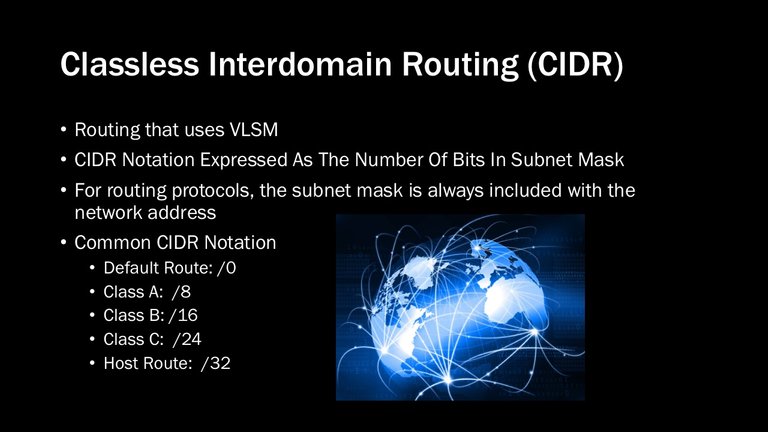
The combination of CIDR with VLSM allows a lot of flexibility in how IP addresses are allocated and advertised. It allows for hierarchical addressing, where a larger block of IPs is subdivided into smaller and smaller blocks. Summarization, which is the act of advertising the top of the address hierarchy while suppressing smaller routes. Also subnetting, which is the method by which you take a larger block of IPs and divide it up into smaller blocks. All of these concepts are discussed in greater detail in the previous course, IP Version 4 Addressing And Subnetting Deep Dive.
Thanks for viewing! In the next part, we will discuss the IP routing and forwarding tables.
Thanks for the engagement on my previous post: @a-non-e-moose
@joshman, Now it's all about the Technology and you are doing effective work by spreading knowledge regarding Technology and Security 🔐. Keep up and wishing you more growth.
Posted using Partiko Android
Thanks, I appreciate your kind words of encouragement :)
Welcome and thank you.
hello O/
Hi
Posted using Partiko Android
This post has been voted on by the SteemSTEM curation team and voting trail. It is elligible for support from @curie.
If you appreciate the work we are doing, then consider supporting our witness stem.witness. Additional witness support to the curie witness would be appreciated as well.
For additional information please join us on the SteemSTEM discord and to get to know the rest of the community!
Thanks for having added @steemstem as a beneficiary to your post. This granted you a stronger support from SteemSTEM.
Please consider using the steemstem.io app to get a stronger support.